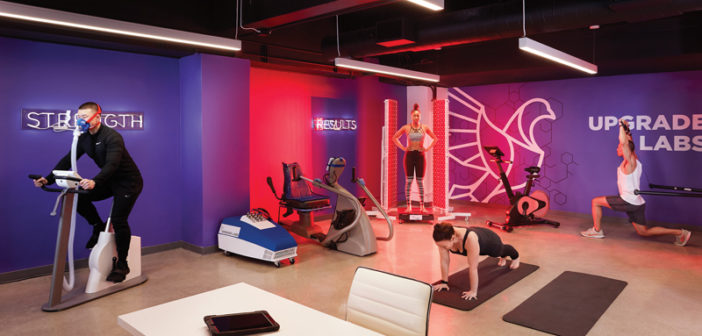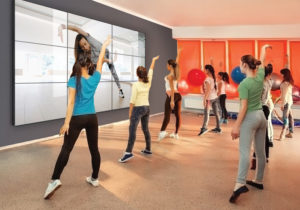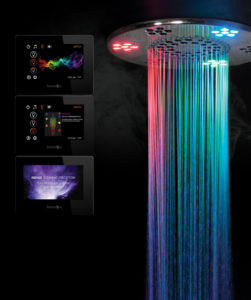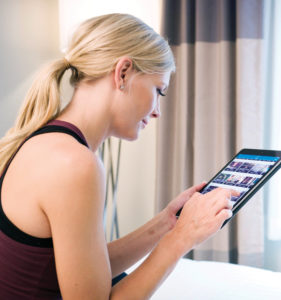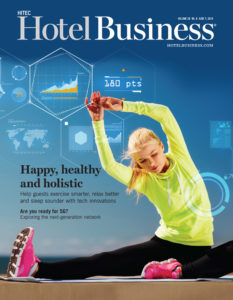Wellness is an important part of the modern hotel experience. From healthier F&B options, to yoga classes on the roof, to upgraded gym facilities, hotels of all kinds are offering guests wellness-focused experiences while they stay. And, like most things today, this experience can be augmented by the right technology. The ways in which hotels are incorporating technology into their health and fitness offerings are varied, and will continue to evolve.
Certainly, there are major opportunities in the wellness-focused market. “We know this is a $242-billion market,” said Larry Hall, CEO, Pure Wellness. “This isn’t net new business. These are people who are traveling anyway and have a wellness focus. The question then becomes what do they expect when they travel? Their expectations vary greatly—from holistic and comprehensive to just wanting an option other than a greasy hamburger. The industry is trying to do pieces of that wellness puzzle; it runs the gamut.”
However, he said, more and more travelers are taking a holistic view of wellness—and technology is partly the reason why. “There’s this convergence where Apple focused a tremendous amount on wellness and data, and that helped create a greater awareness of wellness, and, therefore, the wellness-minded traveler,” Hall explained. “We’re aided by technology that promotes greater wellness. It becomes self-fulfilling. There’s that old adage: What gets measured gets managed. When we start to measure our various wellness attributes to these devices, we start to manage it well. That has contributed to the emergence of the wellness-minded traveler.”
Because, of course, what guests do at home is mirrored by what they do in hotels. Bryan Green, founder of Aktiv, noted, “People don’t want to have their routine disrupted if they can avoid it. Best practices in hospitality are always about trying to make sure the guest experience is equal to or greater than what they achieve at home.”
That guest experience must be achieved throughout the hotel—because guests expect what they want wherever they want it.
“It’s about accessibility,” said Andrew Evenson, director, brand, FitnessOnDemand. “Whether that’s in the fitness facility or whether that’s in room, consumers now are used to having that accessibility. We have people who have multiple gym memberships—you might be a member of a boutique club, and then you’re also a member of a 24-hour, low-cost club, and then you’re supplementing your workout with videos at home. People expect that accessibility, so instead of having a limited amount of equipment in a fitness facility, people want to be able to access what they want when they want it.”
“Hotels need to find a way to be in lockstep with the wellness-minded traveler and offer things that allow them to continue with the activities and support functions they realize at home and in offices,” Hall said.
Fitness center evolution
Fitness centers have long been a brand standard for hotels—it was necessary to have them, but for many hotel properties, it was just a box to check: a few treadmills and weights in a small room in the basement. Now, though, hoteliers are opening up the fitness center, and filling it with new equipment, aided by technology.
“Hotels with outdated fitness centers and expired equipment in a dingy space are now affecting their guest scores, reviews and, ultimately, occupancy levels,” said Jake Benner, director of sales, hospitality, cruise & fitness, LG Electronics USA. “From air purifiers to mood lighting to playing customized content on a video wall, there are many technologies that are helping to transform the hotel fitness space.”
“Fitness centers are definitely becoming larger,” Evenson said. “No longer is it good enough to just have that box checked, to show that’s an amenity; now, it’s more about what you have in there. For us on the technology side of it, we’re finding ways to activate that space and make it more usable for the guest. As it gets larger, that’s a lot of square footage that could be used for other things, so it’s important they have the type of equipment in there that’s going to get use. That’s where we can activate that space with a variety of content that will facilitate a workout regardless of what the person is looking to do. That helps make the space more usable.”
Green agreed. “The biggest trend change we see in fitness spaces is that they’re actually creating more space by either making larger facilities or renovating existing facilities to create more movement, with open areas for functional training,” he said. “What that requires is a lot of the traditional equipment, like cardio and strength, being thinned out; they’re creating more open areas to use things like balls, bands, mats and other training tools that have become extremely popular in the health-club space.”
But those changes require instruction—and for hotels, live instructors aren’t feasible 24/7. “Some do have live instructors and that’s great to offer, but it’s not reasonable to offer that 24 hours,” Evenson said.
Benner agreed. “If a hotel has a studio space that’s mostly unused except for a rare instructor-guided workout or basic stretching, instructors are expensive to hire and may not show up,” he said. “The answer is to provide on-demand or scheduled virtual instruction where guests can select their own workout or favorite instructor on a kiosk and play it on a large panel, DirectView LED or video wall. Hotel GMs can also run the displays on a schedule, so guests understand what workouts are happening at what times.”
Technology enables hoteliers to change the setup in the space. “We have products that take up as small as 10 ft. on the fitness floor and can go out into the open fitness area, and then we have our more common product that goes into a studio or functional training space that connects with a larger-format TV,” Evenson said. “From the programming standpoint, we have 2,500-plus different classes, so when we onboard, our customer experience team works with hotels on deciding what the right schedule is for them and deciding what the right content is for them. If they don’t have cycle bikes, we’re not putting cycling content on there. If it’s not a functional training space, yoga is not the right content. We do a lot to customize that with them, and it’s also full control for them, so depending on how involved they want to be with it, they can update that content, preschedule classes, etc.”
Evenson added that this also enables hotels to promote well-known fitness instructors. “We work with a lot of big-name trainers, so it gives them the ability to promote those types of names as offerings in the facility then,” he said.
Green noted that Aktiv’s virtual platform creates a predefined space, roughly four by eight in nature, the same size as what would otherwise be dedicated to a treadmill. “It allows them to have an interactive experience with the kiosk in the sense that they can build a workout of their preference, both by time and duration of exercise intervals; and the type of exercise or genre they might choose—it could be yoga or high intensity interval training or just recovery or stretching. It will build a workout for them based upon those choices, as well as allow them to pick a personal trainer from within the program,” he said. “Then, the program will guide them and reference the actual equipment located within the bay.”
“Fitness content providers have also developed content that is more personalized on a single, smaller, touchscreen display,” Benner said. “Shorter workouts are offered in this case, and are more focused on specific muscle groups.”
“One thing we’ve seen, and it’s more on the experimental track, is leveraging displays within fitness centers with an animated fitness coach that would display on a mirror display or some other unit,” said Fred Crespo, director of technology & business development for hospitality TVs at Samsung Electronics America. “I’ve seen some brands want to experiment with an avatar-like experience where you’re virtually coached through your movements—and because it’s a mirror display, you can make sure you’re doing your movements correctly.”
Martin Tobias, CEO of Upgrade Labs, which has a location in The Beverly Hilton, noted that guests want something more targeted than they did before. “What we find that people really want, need and are connecting with in our first property at the Hilton is treatments targeted at boosting their performance or boosting their ability to recover from the flight, getting ready for the meeting or the runway show they have, and having a personalized trainer there that can give them a really efficient workout,” he said.
Upgrade Labs is based on the idea of biohacking, which has two parts: One, that you can change your biology with technology; and two, that you can encourage your body to do what you want it to do faster than your body is going to do it by itself by using some technology to encourage the body, he said.
“For example, take the swollen legs from an airplane. It’s well documented that happens, and because of the pressure change, you get inflammation in your legs. That can cause soreness,” Tobias said. “We’ve got a machine that you sit in, and it does a lymphatic system massage designed to reduce inflammation in one session. You’re going to feel better right away as opposed to letting your body get rid of that over two or three days. That’s one technology that can get your body to do something it’s going to do anyway, but faster.”
He also pointed to the Cold HIIT, which combines compression and cooling technology, helping you make dynamic strength gains and accelerate recovery in a twenty-minute, high-intensity workout. “It gives you the hormonal response of a 2.5 hour workout in 20 minutes,” he said, noting that he understands if people are skeptical at first, given the many fantasy fitness ads people see on TV. “But we’re at a point now where this intersection of scientifically backed technology and new advances in technology have come together to deliver much more efficient workouts. There’s a real value in that.”
Other technologies available at The Beverly Hilton include AI Adaptive Cardio, in which the bike learns your body to give you a personalized workout; cryotherapy; and an infrared sauna with chromotherapy, or color therapy, designed to help boost your mood and promote an overall sense of harmony.
While, traditionally, hotels were used to having technology that guests couldn’t find at home, that trend has switched: Now, hotels have been playing catch up to residential technology. However, Tobias noted that hotels have the opportunity to change that in the wellness space. “A lot of the technologies we implement are expensive and not the kind of thing they’ll have at their home. A cryotherapy machine is $100,000,” he said. “Certainly, there are people who can buy them at home, but it’s the kind of thing people won’t have maybe even in the whole city where they live—and certainly not in their house. It’s a time for hotels to be able to introduce this and bring something unique to travelers, which is exciting.”
And while Upgrade Labs only has one hotel location open right now, Tobias noted that will change. Prior to partnering with The Beverly Hilton, the company “had been wanting to show the benefit of our technology in a hospitality environment, and we had a lot of opportunities. We had about 10 hotels come to us, but since we’re based in L.A., it was better to do our first foray in a hotel that was close to our corporate headquarters. After this year, we’re building two more locations in L.A., and then we’re going to be ready to support hotels in other cities, now that we have the programming down.”
Tobias noted that target hotels will include those that have a lot of events business as well as destination hotels.
In-room experience
While fitness centers are important to guests, having an in-room experience is also becoming more popular. After all, some schedules dictate that a guest might not be able to make it to the fitness center during its opened hours. And, other guests might not be inclined to work out in front of their colleagues and clients.
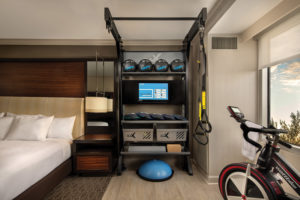
Aktiv’s solution, shown here in one of Hilton’s Five Feet to Fitness rooms, enables guests to work out in the room.
In-room fitness, Green said, “creates convenience and additional privacy, assurance they’re going to be able to have an uninterrupted workout routine.”
But, Green added, it’s important to do in-room fitness right. “If we throw in a yoga mat and a couple of rubber bands and don’t give guests guidance on how to use stuff, they’re going to be like most travelers who have the best of intentions when they go on the road to keep up with their workout, but they often don’t,” he said.
That’s where technology comes in. Hotels can have a personal fitness kiosk, as Hilton does in its Five Feet to Fitness rooms, or can enable OTT content on the hotel TV. For instance, Hilton’s fitness rooms include an indoor bike from British cycling innovator Wattbike; a Gym Rax functional training station; and the Fitness Kiosk, a touchscreen display embedded within the Gym Rax system where guests receive equipment tutorials and follow guided workout routines. In partnership with Aktiv, Hilton has created more than 200 bespoke fitness videos in categories ranging from cardio, cycling, endurance, strength, HIIT, yoga, stretch and recovery.
Benner noted that LG is working with a partner to bring workouts and instructors to guestroom TVs as well as via an OTT application. “One specific trend we are seeing is that some hotel brands are creating their own in-room fitness content,” he said. “They are either producing their own with in-house instructors or opting to hire celebrity instructors to offer in-room workout options.”
“What we’ve also seen is a significant number of OTT providers offering fitness and lifestyle information playing into the smart TV space for hospitality,” Crespo said. “They’ve bought into the idea of using a smart TV as a primary delivery mechanism into these spaces. Marriott is now broadcasting one of its curated apps as a fitness app. Hyatt and Hilton are doing something similar around introducing lifestyle and fitness apps on their displays, and that’s all generated by the app availability on our smart TV platform.”
Of course, casting also plays a huge role in this—when guests want to follow their own fitness routines at hotels, that could mean using their own fitness videos and content. “A lot of people carry with them, on their mobile devices, all of the apps that do personal fitness tracking, so what we also want to support is the casting of that content to the TV,” Crespo said. “If the hotel wanted to leverage casting of that content to the TV, while also providing you the equipment you need to facilitate a good workout in the guestroom, like elastic bands or mats or even sneakers and workout clothes, they could. Even if the guest is not well-equipped for a workout, if you’ve got a mobile phone and your content there, all you need is the other stuff.”
And that’s true no matter what type of hotel a guest is staying at. “There’s a fair amount of democratization of content and devices,” Crespo said. “A lot of mid- and limited-service hotels have been deploying smart TVs for years now, so the question is what’s the incremental cost for additional services or for activating an app that may already exist in the library? What does it actually cost? In some cases, we’ve seen some lower chain scale brands actually be very lifestyle driven because of the proper use of technology and the appropriate investment in what they’ve been doing over the years with infrastructure. If they’ve got good wireless and a good TV, there’s opportunity to leverage content that could exist off property and really cost the property nothing in terms of incremental costs, but still play a significant role in enhancing the in-room experience. I say that because although the initial instinct is to expect this on the upper end of the scale, we’re seeing this filter down across unexpected chain scales.”
Holistic wellness
Of course, wellness isn’t just about fitness—and that’s playing itself out in myriad ways throughout the hotel, particularly the guestroom. It’s not just fitness equipment making its way into the room—hotel brands are outfitting wellness-oriented rooms with amenities like purified air pumped through the hotel’s HVAC systems, lighting designed to enhance better sleep/wake cycles and upgraded showers with chromatherapy incorporated.
“We all know traveling can have a tremendous impact on our health and well-being, even beyond experiencing jet lag; travel also leads to higher stress, energy deprivation and higher susceptibility to getting sick,” said Peter Scialla, president/COO, Delos. “By designing spaces that can not only reduce the negative impacts of travel, but actually enhance health and well-being, we’ve got a unique opportunity to transform the hospitality industry.”
And, much like in-room fitness, that’s at every level of hospitality. Hall noted, “We tend to do very well in upscale and upper-upscale, but our Pure rooms exist in a very wide range of products from Ritz-Carlton to Hampton. We’re finding the wellness-minded traveler isn’t particularly focused on one market segment. They may spend much less time in the economy segment, but when you move above that, it really runs the gamut.”
Regardless of chain scale, sleep is the same—and there are many ways sleep can be affected. “You would think there are a limited set of inputs that affect people’s sleep—the kind of mattress, the food they’ve taken in, the liquids they’ve consumed. But it’s much broader than that,” Scialla said. “Sleep as a category is affected by the light people receive into their eyes, air quality, and it’s affected by mattresses; there are so many elements. We know prolonged exposure to artificial light can destabilize our sleep/wake cycles. We have a bright white energizing light that can help you wake up in the morning and reduce jet lag, and gradual dawn simulation can help you wake up gently. Meanwhile, warmer lights at night can help you get ready for sleep and allow your body to start producing melatonin. Equally, you want as little light as possible overnight. You have air purification that filters allergens and toxins and microbes to improve the air quality so people can breathe cleaner, more vitalized air in the room.”
When the room is connected through technology, it can create a better well-being experience for guests. “When we layer in how to leverage the TV in the guestroom, that’s when things become interesting in the introduction of content and IoT,” Crespo said. “Hotels are really thinking about how they can create a space within the guestroom that allows them to pump in fitness-on-demand content via a smart TV interface, but then also allows the guest to participate in many different examples of the holistic use of that content. For instance, circadian rhythm, where if you want to introduce a nice, graceful wakeup scene and leverage IoT, you’ve got the drapes that open on demand, you’ve got a sunrise scene on the television, you’ve got audio playing specifically either through the TV speakers or soundbar, or some other audio technology we interface with. This allows for you to be gently rocked awake through the use of device, IoT and content integration all at once.”
Delos’ team looks at the science behind each technology. “The lab team carefully curates and vets wellness smart-home technologies from third-party vendors to integrate them into our holistic wellness programs and solutions,” Scialla said. “It’s based on peer-reviewed research that links environmental conditions with human outcomes. We may look at dynamically changed lighting that can match the color and temperature of the sun, or air filtration that removes particulates to address respiratory function.”
Even guest bathrooms are getting in on the action. Mitch Altman, CEO of ThermaSol, said, “Wellness has become an important factor in choosing a hotel. A generously sized rain shower, upgraded lighting, Bluetooth-capable music and an easy-to-use steam shower are the height of a spa experience at a hotel. Many customers are already living the wellness lifestyle in their own homes, and they want to ensure that they continue to meet their health needs while traveling. It’s these kinds of amenities that define a brand, giving guests reasons to stay loyal while traveling so they come back again and again.”
And it’s all about personalization. “Guests are not only seeking a steam shower experience, they’re looking for one that speaks to their own personal concept of wellness,” he said. “A customized shower experience begins by selecting the perfect amenities for one’s own needs and preferences. Maybe one guest’s ideal shower includes having the ability to listen to a favorite podcast while having a hot steam. Another guest might prefer the idea of a steam shower with soothing, meditative violet light and pure quiet to bring them calm. Each guest wants to create their own personal wellness oasis, and with today’s technology, that’s attainable.
“It’s no longer true that relaxation is counterintuitive to the concept of high-tech,” he added. “In fact, technology actually enhances the idea of health and wellness. As technology evolves, so will the ability to further personalize the shower experience, to the point of being a bespoke shower tailored to each user’s personal taste.”
And that’s true for the entire ecosystem. Scialla noted that Delos has introduced a wellness brain called Darwin in residential concepts. “This has got applications to all verticals,” he said. “It integrates the devices that work on air, water purification, comfort and lighting, but instructs them through a suite of algorithms that, in a connected world, can really change the game as it relates to personalizing settings, so that each individual can have a different experience based on their own health needs, their own travel schedule.
“The next evolution of this is personalization, so individuals are experiencing a different indoor environment that’s calibrated carefully to meet their needs,” he continued. “You can imagine by inputting some simple flight information, the lighting in the room would be set at a personalized level different for folks to help to reverse the effects of jet lag, as one example.”
Personal devices
Of course, this also depends on the integration of hotel technology with guests’ personal devices and data—something that is happening across the board in all areas of the hotel experience.
“To me, this is a really interesting angle,” Hall said. “If you think about what Apple’s strategy is with the watch and the phone, it’s to integrate all wellness activity into that single device. I have no doubt that over time, those apps of ours will become the repository for all of our wellness data. Every time I work out, my data from my bike gets to my watch, my phone and my cloud, all automatically; that’s all integrated. When I step on my scale in the morning, my weight and BMI and other metrics are all uploaded and become part of my daily record. I take my blood pressure, and that goes to my iPhone and watch. It’s remarkable how all of that data comes together.”
How does that apply to the hotel industry? “Hotels are an extension of our personal lives,” he said. “When you see how technology evolves in the hotel space, it mirrors where technologies evolve in the commercial real-estate space and our homes. I think the hotel industry can start to service the wellness-minded traveler a little better if they start to think about how to integrate what we do at a hotel with what they’re already doing at home. History tells you that’s what they’re going to expect. Maybe there’s a scale in the bathroom that will upload to my phone, or workout equipment in my room or in a fitness center that regularly uploads my data to my fitness profile.”
And the sleep data that personal devices collect can certainly affect hotels. “I get a measure of how I slept every night: when I slept, how long it took me to go to sleep, the quality of that sleep, when was I in my REM cycle,” Hall said. “All that data will be done in a hotel. If I’m getting a better night’s sleep in a particular hotel, then I’m going to tend to migrate to that property. I think there will be an eventual integration of personal fitness and wellness technology manifesting itself in wearables and phones. It’s inevitable because that’s what we see in our homes, and we’re going to expect to see that in hotels soon.”
Green agreed. “There are some really good things out there, not the least of which is heart-rate-integrated concepts,” he said. “Guests will often travel with some sort of wearable—an Apple Watch, Fitbit, etc., but it could be as simple as a chest strap. That can communicate with their app, but increasingly what’s happening is major manufacturers of equipment have also found integrations with this type of heart-rate monitoring technology, so when you interact with those pieces, including our own unit, you now have biometric feedback—so it’s not just a mobile experience, it can actually integrate into the actual live environment.”
Technology will continue to drive change. “Besides being right on trend, wellness is not a fad. It’s a result of increased transparency and access to information, and not just information on the types of things that affect your health, but information on what the indoor environment is producing as it relates to air quality,” Scialla said. “We’re not too far away from sensors being so cost effective that everyone knows what the air quality is in a continuous monitoring fashion, right where they’re standing, and that increased transparency and access to information, including on your mobile device, is going to continue to be a demand driver.”
Tobias added that guests are becoming increasingly aware of their own wellness as well. “I’m excited technology is catching up to the wellness space. Wellness has been sold as an experience without a lot of data behind it for a long time. I’m excited we can deliver wellness with a measurable benefit—you are quantifiably healthier with what you’ve done,” he said.
“It all comes back to same thing—accessibility and instant access,” Evenson said. “That’s the world we live in now, and the traveler is no different; it’s absolutely the expectation.”
“The industry is increasing its awareness that this is a market segment that needs to be served,” Hall agreed. “I do think the industry is going to need to find a way to deliver wellness on a more holistic basis. It’s not just a point solution like a fitness center, but it’s more about changing how they think about offerings to their community… The hotel industry will figure it out; it just takes time, but the industry is experimenting and showing a willingness to try things to see what makes sense.” HB

